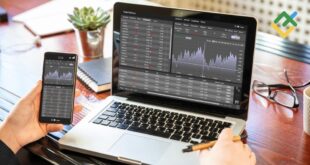In today’s dynamic financial markets, having the right trading platform can make all the difference. Whether you are a beginner dipping your toes into the trading world or a seasoned investor, selecting the best trading platform tailored to your needs is essential. A well-suited platform not only simplifies trading but also enhances your overall experience, enabling you to make informed decisions and optimize your portfolio.
Here is a step-by-step guide to help you choose the best trading platform for your needs:
Step 1: Define Your Trading Goals
Before diving into the world of trading platforms, it is crucial to identify your objectives. Are you looking to trade stocks, forex, cryptocurrencies, or other assets? Do you intend to day trade, swing trade, or invest long-term? Your trading goals will guide you in selecting a platform that aligns with your strategy. For instance:
- Day traders need platforms with fast execution speeds and advanced charting tools.
- Long-term investors may prioritize user-friendly interfaces and comprehensive research tools.
- Crypto enthusiasts will look for platforms offering a wide range of cryptocurrencies and secure wallets.
Clearly outlining your goals will help narrow down your options.
Step 2: Assess Your Skill Level
Different platforms cater to different levels of experience. Beginners often prefer platforms with intuitive designs, educational resources, and demo accounts. On the other hand, advanced traders might seek out platforms with robust technical analysis tools, customizable interfaces, and access to sophisticated order types.
If you are new to trading, consider starting with a platform that offers tutorials, webinars, and support to help you learn the ropes.
Step 3: Evaluate Security Measures
Security is a non-negotiable factor when choosing a trading platform. With cyber threats on the rise, you need to ensure that your funds and personal data are protected. Look for platforms that offer:
- Regulatory Compliance: Ensure the platform is regulated by reputable financial authorities such as the SEC, FCA, or ASIC.
- Encryption Technology: Platforms should employ encryption to protect your data.
- Two-Factor Authentication (2FA): Adds an extra layer of security to your account.
- Insurance Policies: Some platforms provide insurance for customer funds in case of breaches or insolvency.
Conduct thorough research on the platform’s security features and read reviews to assess its reputation.
Step 4: Analyze Fees and Costs
Trading platforms often have varying fee structures that can significantly impact your profits. Be sure to understand all associated costs, including:
- Trading Fees: These include commissions, spreads, or a combination of both.
- Deposit and Withdrawal Fees: Check if the platform charges for funding or withdrawing from your account.
- Inactivity Fees: Some platforms charge fees if your account is inactive for a specific period.
- Additional Costs: Consider fees for premium features, data subscriptions, or advanced tools.
Compare fees across platforms to ensure you’re getting the best value for your trading style and frequency.
Step 5: Consider Available Assets
The range of tradable assets is another crucial factor. While some platforms specialize in specific markets like stocks or forex, others offer a wide array of assets, including:
- Stocks
- Bonds
- Forex
- Cryptocurrencies
- Commodities
- ETFs (Exchange-Traded Funds)
- Options
Select a platform that offers the assets you intend to trade. A diverse range of options can be advantageous if you wish to diversify your portfolio.
Step 6: Examine Trading Tools and Features
A platform’s tools and features can greatly enhance your trading experience. Key features to look for include:
- Charting Tools: Advanced charting capabilities with indicators, drawing tools, and customizable timeframes.
- Order Types: Access to various order types like market, limit, and stop orders.
- Automation: Options for algorithmic trading or integration with third-party bots.
- Research and News: Access to real-time news, market analysis, and research reports.
- Mobile App: A robust mobile app for trading on the go.
The right tools will depend on your trading style and the level of control you desire.
Step 7: Test the Platform’s Usability
The platform’s user interface plays a significant role in your overall experience. A cluttered or overly complicated interface can lead to mistakes and frustration. Look for:
- Ease of Navigation: Intuitive design and clear layout.
- Customizability: Ability to adjust the interface to suit your preferences.
- Demo Accounts: Test the platform without risking real money.
Spend time exploring the platform’s features to ensure it meets your expectations.
Step 8: Research Customer Support
Reliable customer support can be a lifesaver, especially during critical trading moments. Check for:
- Availability: Ensure customer support is available during trading hours or 24/7.
- Channels: Look for multiple contact options like live chat, phone, and email.
- Response Time: Read user reviews to gauge the responsiveness of the support team.
Good customer support reflects a platform’s commitment to its users.
Step 9: Read Reviews and Compare Platforms
Take time to read reviews and ratings from other users. Websites, forums, and social media can provide insights into:
- User satisfaction
- Platform reliability
- Potential issues or red flags
Additionally, compare platforms side by side to identify the one that best meets your criteria.
Step 10: Start Small and Scale Gradually
Once you’ve chosen a platform, start by trading small amounts to familiarize yourself with its functionality. This approach minimizes risk and allows you to test the platform before committing larger sums. Over time, as you gain confidence and experience, you can scale up your trading activities.
Conclusion
Choosing the best trading platform for your needs requires careful consideration of your goals, skill level, and preferences. By following these steps, you can identify a platform, such as best website Shenzhou Capital, that aligns with your trading style, offers robust security, and provides the tools necessary for success. Remember, the right platform is not just a tool but a partner in your trading journey. Take the time to make an informed decision, and you’ll set yourself up for a more rewarding trading experience.
 Our Gateway to Insightful Blogging Exploring Ideas, Sharing Knowledge, Inspiring Minds
Our Gateway to Insightful Blogging Exploring Ideas, Sharing Knowledge, Inspiring Minds



